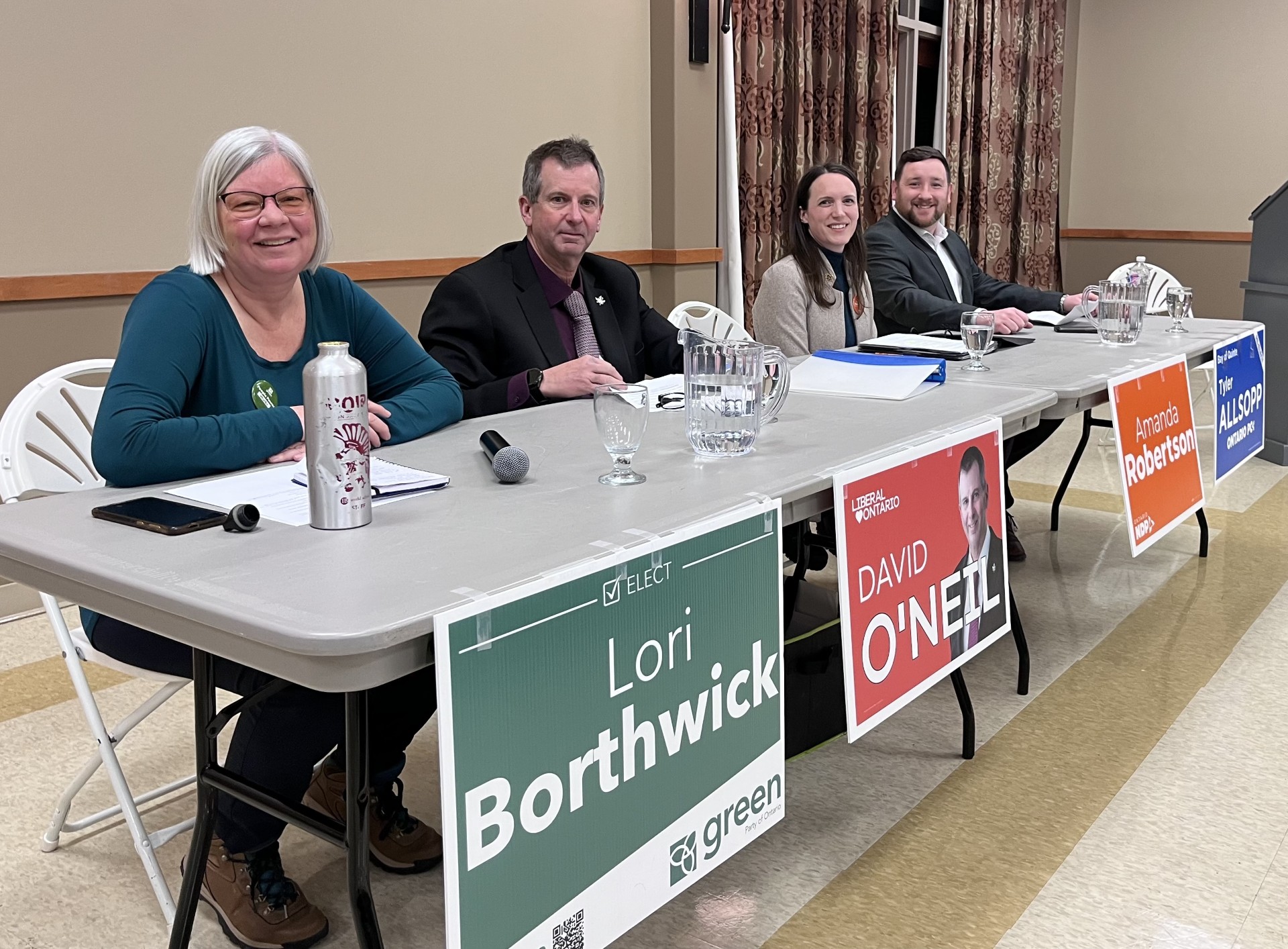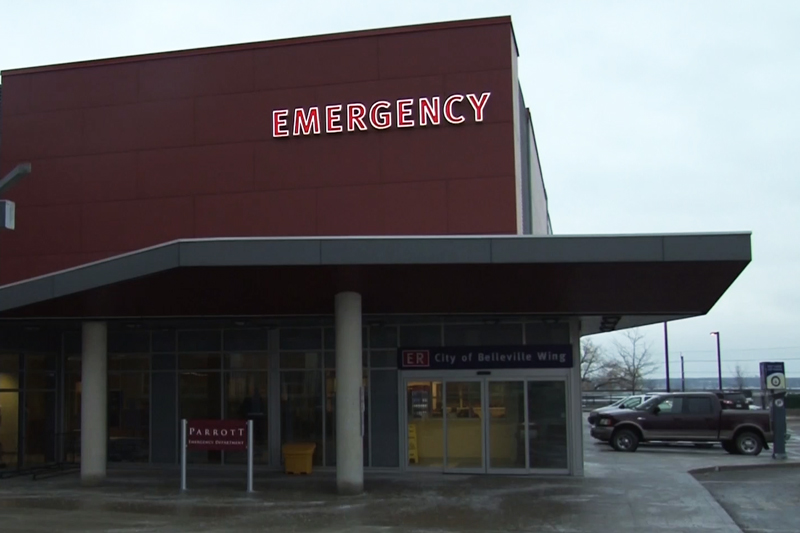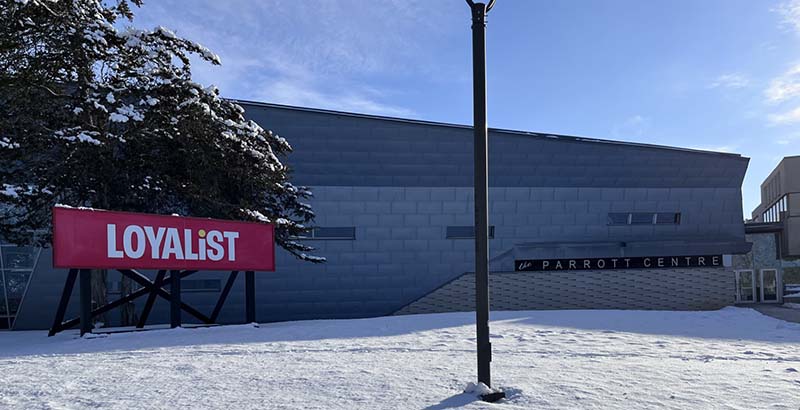
Lori Borthwick (Green), David O’Neil (Liberal, Amanda Robertson (NDP), and Tyler Allsopp (PC) sit in Highland Hall moments before the meeting began. Photo by Sam Franks.
By: Sam Franks
WELLINGTON – The four provincial candidates for the Bay of Quinte riding gathered to make their pitch to members of the community at the Lehigh Arena in Wellington on Monday Feb. 10.
About 200 people were in attendance, with more than 60 people online.
The night was moderated by Jennifer Armstrong of the Wellington Community Association.
Plans for education and dealing with tariffs were discussed but healthcare and housing concerns were the big concerns.
Liberal candidate, David O’Neil, NPD candidate, Amanda Robertson, Green Party candidate Lori Borthwick and PC‘s Tyler Allsopp were ready to share their parties future plans.
O’Neil was the first to respond to healthcare concerns and said that 2.5 million Ontarians don’t have access to primary care.
“Belleville General Hospital has one of the longest wait times in the province. Trenton Memorial Hospital needs a dialysis unit. Thousands have been on the waiting list for years. 11,000 people died while waiting for health care last year,” O’Neil said.
O’Neil said that Ford’s government failed to end hallway healthcare.
“I think we need to get every person a family doctor in four years, which is part of the Liberal plan; shorten emergency wait times, preserve and expand services in our regions hospitals, reduce surgery wait times,” said O’Neil.
O’Neil said the Liberal plan also includes building two new medical schools and expanding current schools by doubling the number of accepted students.
Robertson said her husband is a family doctor and the job demands are growing.
“A big piece of solving some of the crisis is making sure that we’re improving the environments that our physicians and our health care workers are practicing in, because until we start to improve things for our doctors, our nurses, our PSW’s, they’re going to continue to bleed out of our system,” Robertson said.
Robertson said that the biggest way to fix the healthcare issue is to invest in the workforce.
“We can create new family health teams and we can create new community health centres, (right now) it is not a desirable model for these health care workers to work in,” Robertson said.
The NDP’s plan includes recruiting 3,500 doctors over four years. The NDP also plans on increasing the healthcare budget and adding 380 more primary care teams across the province.
Robertson said that there are many holes in the OHIP system.
“We have a government and a health plan right now that basically says: if you’re too old, then your healthcare isn’t as good as people who are younger. So really tackling some of these arbitrary limits and cutoffs to make sure you guys have access to pharmacare you need, access to the dental care you need,” she said.
Green Party, Lori Borthwick has first-hand experience as a healthcare worker for over 30-years.

Outside Belleville Emergency Department. Photo by QNet News.
“When I started working at Belleville General Hospital, we had just under 500 hospital beds. There were no people in the hallways of our emergency departments because we had beds to move the patients that came into emerge, into a bed. Over the years of Liberal and Conservative and NDP one time, we are down to 192 beds,” Borthwick said.
Borthwick said that more people are crowding hospitals due to not having access to a doctor.
She said she is offended by the current state of healthcare.
“1 in 4 of us in this area have no connection to our healthcare system,” Borthwick said.
The Green plan included investing more money and a petition for the legislature of Ontario to prioritize the Bay of Quinte riding.
“I’m sure whoever is your MPP will be happy to present that petition on Queen’s Park,” Borthwick said.
PC Candidate, Tyler Allsopp, says that facts need to be agreed upon before solutions can be agreed.
“Ontario has the shortest wait times to access healthcare. We also have the highest patient attachment rate of any province in Canada,” Allsopp said.
Allsopp said that those numbers might not be accurately represented because of northern and rural communities, like the Bay of Quinte.
“We’re investing heavily in attracting those doctors. We introduced the learn-to-state program which helps fund doctors who are willing to practice in under-served areas by giving them their tuition, about $25,000 a year, over a six-year period,” Allsopp said.
Allsopp said one of the biggest challenges is that doctors aren’t created overnight and things take time to improve.
“We’ve also put forward $50-billion to build new hospitals all across Ontario, including $200-million for the Picton Memorial Hospital,” Allsopp said.
Allsopp said the Ontario government introduced the As of Right Legislation allowing doctors from other provinces to practice in Ontario.
“We have hired about 15,000 new doctors since 2018, as well as 100,000 new nurses. We’ve also increased residency seats by 700 (260 under graduates and 449 post graduates), we’ve earmarked 60% of those for family doctors and we’re also prioritizing all of those spots for Ontario students because they’re much more likely to remain in Ontario and work in the communities where we desperately need more healthcare,” Allsopp said.
Another issue of concernt to the audience was housing.
O’Neil said that housing for seniors needs to be improved which will simultaneously help with some stresses in healthcare.
O’Neil recalled his time as a Quinte West councillor and applying for senior-living programs, but not receiving approval.
“I also believe there should be increased funding and supports for senior services such as, in-home care services, personal support worker visits,” O’Neil said.
“Our Liberal plan will slash taxes on new homes, improve renter rights and save you move,” O’Neil said.
Borthwick said that the Greens housing plan starts with those who need it the most.
“We need to plan to cut taxes on people that earn less than $65,000 a year, or households that earn less than $100,000 a year,” Borthwick said.
The Green plan includes increasing rent control for older buildings and vacant buildings, meaning a landlord cannot increase rent upon an eviction for a rental unit.
Borthwick said that houses are not being designed for the communities needs but for profits.
“We need smaller houses that are affordable,” Borthwick said.
She said that the Greens have a plan to build over 3,000 affordable homes with non-profit partners.
Robertson said that cost-of-living was one of the biggest concerns she’s heard while knocking on doors.
She said that more private equity firms are buying buildings and raising rent. She plans on limiting Airbnb’s so buildings aren’t sitting vacant.
“As part of our Homes Ontario plan, we’ll be looking to build 1.5 million new homes by the year 2034 and we’d be building or acquiring 300,000 permanently affordable homes, as part of that 1.5 million,” Robertson said.
Allsopp responded that the PC government introduced similar plans with building 1.5 million homes but by 2031.
“This is a significant problem across Ontario and there’s a couple of different things that we’ve done. We’ve changed the provincial policy statement in the building code to allow for initiatives like modular homes as well as tiny homes to be built. We’ve also increased density around transit stops, so the places where people live and work are able to get housing that’s affordable,” Allsopp said.
In wake of cuts and suspensions at Loyalist College, education was another popular point of discussion.

Outside of Loyalist College. Photo by Sam Franks.
O’Neil said that the Ontario college’s are in financial strain as a result of policies from the current provincial government.
“If Loyalist were to close there would be dire consequences for the Bay of Quinte region,” O’Neil said.
He said Loyalist College helps create jobs and is an accessible college for low-income people already living in the region.
“What good is freezing tuition rates if local students have to travel somewhere else to get their education? Those students now have to pay for accommodations and travel, which they probably can’t afford. We need to help Loyalist College with committed funding to ensure they don’t close,” he said.
Robertson is a school board trustee with Hastings Prince Edward District school board and has been hearing teachers concerns for years.
“The reality is we have lost 5,000 classroom educators since 2018. While funding for education is up overall per pupil funding, when indexed to inflation, is down $1,500 a student per year,” Robertson said.
She said schools are the backbone to many of the social problems like hunger.
“NDP has a plan to introduce a universal food program, hopefully in conjunction with the federal government. We also have plans to induct special education funding allocated based on need,” she said.
Robertson said the NDP government would spend $1.4 billion to the post-secondary sector and work with colleges so they can offer diverse programs and remain open.
Allsopp said the Ontario government has made meaningful changes to the education system.
“We brought the Ontario Youth Apprenticeship Program back to grade 10, so kids can start the journey into the trades earlier. As we know we have a significant shortage of skilled trades,” Allsopp said.
“I’ve had extensive conversations with the president Mark Kirkpatrick at Loyalist College, and he in fact does not lay the blame for this at the feet of the provincial government,” he said.
Allsopp said the problem stems from the federal governments lack of foresight around international students.
Borthwick was delighted that all other candidates were on the same page with protecting Loyalist College.
“This is amazing. We’re going to be working together, collaboratively to get this situation fixed. I will say, despite the money that Tyler has mentioned running into the education system – we’re still funded at the lowest level of any province in Canada,” Borthwick said.
“We shouldn’t be cutting our curriculums, we need to fund them,” she said.
The election takes place on February 27.
 Print This Post
Print This Post






